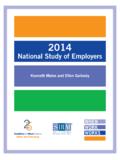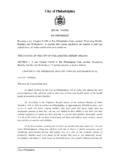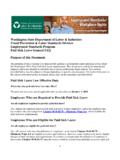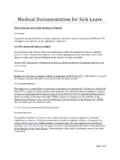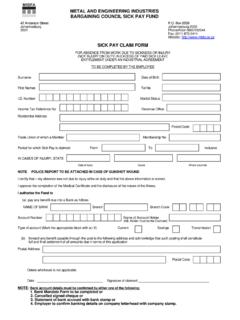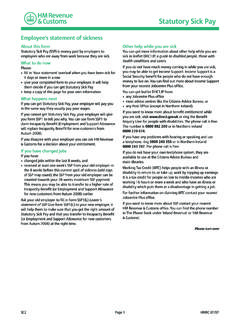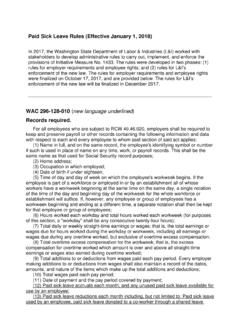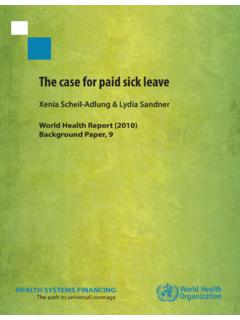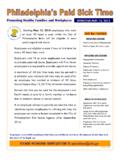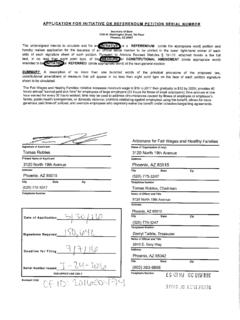Transcription of ACKNOWLEDGEMENTS - Families and Work Institute
1 ACKNOWLEDGEMENTSF irst, we give special thanks to Kathleen Christensen of the Alfred P. Sloan Foundation for supporting this research in 2005, 2008 and 2012. Her wise counsel has affected our work and this report in countless and invaluable ways. We are grateful to the Society for Human Resource Management (SHRM) for their ongoing support of the National Study of Employers and SHRM s Mike Aitken, Vice President of Government Affairs and Lisa Horn, Director, Congressional Affairs for their insightful review of the , we thank the representative group of employers that responded to questions in the 2014 National Study of Employers. We also want to thank the management and staff of Nielsen (formerly Harris Interactive) for their extraordinary efforts in carrying out the interviews for this also want to thank S.
2 Evren Esen, Director of Survey Programs at SHRM, Jodi Levin-Epstein at CLASP and Susan Lambert at the University of Chicago for their knowledgeable and wise reviews of the questionnaire and results. Finally, our thanks to Eve Tahmincioglu, Senior Director of Communications at Families and Work Institute (FWI) for the inspiration for this report; John Boose, FWI s Creative Director for his design of the report; and Barbara Norcia-Broms, FWI s Communications Manager, for her proof Time Off, Vacations, sick days and Short-Term Caregiving in the United States: 2014 National Study of Employers Copyright 2015, Families and Work InstitutePaid Time Off, Vacations, sick days and Short-Term Caregiving in the United States: 2014 NaTiONal STUDy Of EmPlOyErSiPaid Time Off, Vacations, sick days and Short-Term Caregiving in the United States: 2014 NATIONAL STUDY OF EMPLO YERSF amilies and Work Institute is a nonprofit research-to-action Institute dedicated to providing research for living in today s changing workplace, changing family and changing community.
3 Since the Institute was founded in 1989, our work has addressed issues in three major areas: the workforce/workplace, youth and early childhood. Families and Work Institute s research takes on emerging issues before they crest and includes some of the most comprehensive research on the workforce available. The Institute s work has helped change the language of debates to move the discussion forward toward more effective and data-driven solutions and to result in action. In addition, because the Institute conducts some of the only research studies of their kind, our studies are quoted in the media more than once a day and are regularly cited by decision makers in business, government and the public. Visit us at in 1948, the Society for Human Resource Management (SHRM) is the world s largest HR membership organization devoted to human resource management.
4 Representing more than 275,000 members in over 160 countries, the Society is the leading provider of resources to serve the needs of HR professionals and advance the professional practice of human resource management. SHRM has more than 575 affiliated chapters within the United States and subsidiary offices in China, India and United Arab Emirates. Visit us at Work Works, a project of Families and Work Institute and the Society for Human Resource Management, is a nationwide initiative to bring research on workplace effectiveness and flexibility into community and business practice. Since its inception in 2005, When Work Works has partnered with an ever-expanding cohort of communities from around the country to: share rigorous research and employer best practices on workplace effectiveness and flexibility; recognize exemplary employers through the When Work Works Award.
5 And inspire positive change so that increasing numbers of employers understand how effective and flexible workplaces can benefit both business and us at Time Off, Vacations, sick days and Short-Term Caregiving in the United States: 2014 NATIONAL STUDY OF EMPLO YERSCONTENTSI ntroduction 1 Overall Prevalence of Vacation Time, sick days and Paid Time Off (PTO) 2 Access to Vacation Time, sick days and PTO by Employee Status 4 Prevalence of Vacation Time, sick days and PTO by For-Profit Status and Industry 5 Amount of Vacation Time, sick days and PTO 8 Short Term Caregiving Leaves Paid and Unpaid 12 Other Characteristics that Affect Paid Leave: Incremental Leave and No Fault Attendance Policies 13 Conclusion 14iiiPaid Time Off, Vacations, sick days and Short-Term Caregiving in the United States: 2014 NATIONAL STUDY OF EMPLO YERSLIST OF TAbLEST able 1: Percentage of Employers Offering Paid Leave Options 3 Table 2: Percentage of Employers Offering Paid Leave Options by Employee Status 4 Table 3: Percentage of Employers Offering Paid Leave by For-Profit Status 6 Table 4: Percentage of Employers Offering Paid Leave to All or Most Employees by For-Profit Status 6 Table 5: Percentage of Employers Offering Paid Leave by Industry 7 Table 6: Summed Percentage of Employers Offering Paid Leave to All or Most Employees by Industry 7 Table 7.
6 Separated Percentages of Employers Offering Paid Leave to All or Most Employees by Industry 8 Table 8: Minimum and Maximums of Paid Leave 12 Table 9: Percentage of Employers Offering Paid Time Off for Short-Term Caregiving Responsibilities 13 Table 10: Percentage of Employers Reporting Characteristics of Their Paid Leave Options 14 LIST OF FIGurESFigure 1: Multiple Job Holders with Only Part-time Jobs 5 Figure 2: Percentage of Employers at Each Maximum PTO and Vacation days Level 9 Figure 3: Percentage of Employers at Each Maximum Vacation days Level 9 Figure 4: Percentage of Employers at Each Maximum PTO days Level 10 Figure 5: Percentage of Employers at Each Minimum sick days Level 10 Figure 6: Percentage of Employers at Each Maximum sick days Level 111 Paid Time Off, Vacations, sick days and Short-Term Caregiving in the United States: 2014 NATIONAL STUDY OF EMPLO YERSINTrODuCTIONF amilies and Work Institute s 2014 National Study of Employers (NSE) is the most comprehensive and far-reaching study of the practices, policies, programs and benefits provided by employers to enhance organizational and employee success by addressing the changing realities of today s economy, workforce and workplace.
7 The NSE, conducted in partnership with the Society for Hu-man Resource Management (SHRM), is based on the Institute s landmark 1998 Business Work-Life Study (BWLS).1 Its scope was broadened to cover issues of importance in the changing economy, and the NSE has been conducted four additional times (2005, 2008, 2012 and 2014) since the BWLS survey was there are similar surveys by employer membership organizations, consulting firms and government agencies, the NSE is notable in that it is the only study of employers in the United States that comprehensively assesses a broad array of programs, policies and benefits designed to enhance employee engagement and resilience to job and personal stressors among a nation-ally representative group of employers. The 2014 NSE sample includes 1,051 employers with 50 or more employees 67% are for-profit employers and 33% are nonprofit organizations; 39% oper-ate at only one location, while 61% have operations at more than one location.
8 Families and Work Institute (FWI) designed the questionnaire and Nielsen (formerly Harris Interactive, Inc.) conducted the interviews on behalf of addition to the April 29, 2014 release of the 2014 National Study of Employers report (available for free download at ), FWI has continued to explore the survey data for ways that organizations can reinvent work to make the most of the diverse talents and experiences of their employees. One line of research is the status of paid leave in the has been a great deal of interest in caregiving leave, even since the release of the 2014 NSE. What has received somewhat less but an ever increasing amount of attention is the idea of man-dating paid leave for self-care, including sick days , which has been considered and/or implemented in places such as New York City3 and In addition, a growing collection of authors in pop-ular media5 including NPR, The Washington Post, New Republic and CNBC have discussed how vacation is valuable to avoid overwork and burnout and to improve engagement.
9 FWI researchers are also being called upon to discuss issues such as burnout6 and the use of vacation Clearly the issue of paid leave for self-care is one that is of mounting importance for the nation. The following report expands the previously released 2014 NSE findings around caregiving leave, with a major emphasis on the current availability of paid vacation time, sick days and undifferenti-ated paid time off (PTO) in the as well as several related policies that influence how these types of paid leave are managed. It focuses primarily on the three types of paid leave that are generally recognized by employers as defined below:Vacation time is generally used to take time away from work for other planned reasons and is usu-ally scheduled in Time Off, Vacations, sick days and Short-Term Caregiving in the United States: 2014 NATIONAL STUDY OF EMPLO YERSSick days are generally used to address times when an employee is unable to come to work for unplanned reasons, such as personal illness, and must schedule time away from work on short no-tice (sometimes informing managers at the moment they should have started working for the day).
10 Organizations vary on whether an employee should use vacation or sick days to cover periods of foreseeable illness or disability ( , recovery from a surgery or giving birth). In addition, organiza-tions can vary on whether employees can schedule short notice leave time for reasons other than personal illness ( , care for a mildly ill child or wait for a plumber to fix a broken pipe) at times creating an additional pool of time, personal days , to address unplanned time off unrelated to personal illness. Paid Time Off (PTO) policies provide employees a specified amount of time away from work for which they will be paid, regardless of the reasons. The paid time off can be scheduled on short no-tice to address unforeseeable events (such as personal illness or other emergencies), but employ-ees are generally expected to inform managers of planned events in advance whenever possible.

